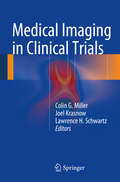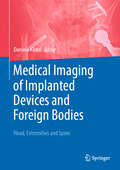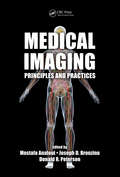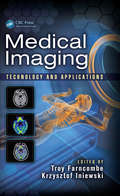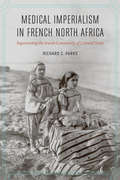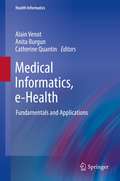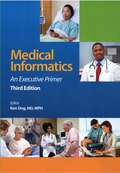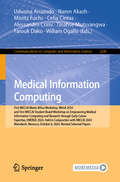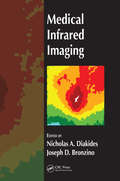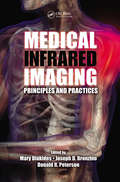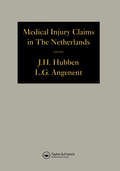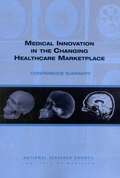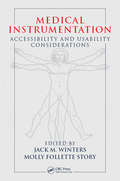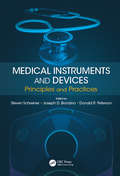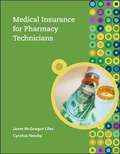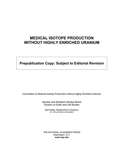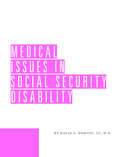- Table View
- List View
Medical Imaging in Clinical Trials
by Colin G. Miller Joel Krasnow Lawrence H. SchwartzIn the last few years the use of medical imaging has increased exponentially in routine clinical practice. This has been reflected in a rapidly increasing use of medical imaging in clinical trials, through all phases. More recently this has culminated in a number of inter-disciplinary meetings with the various stake holders, including the FDA. Changes in the regulatory process has resulted, when it comes to the submission of data to the FDA, in a therapeutic agent where one or more of the trial end-points is the assessment of a radiological end-point. No longer is it sufficient to have the images read by the local investigator site. The FDA has also identified Medical Imaging as one of the key 6 points in the Critical Path initiative which was launched in 2004. This puts a keen focus on the role of imaging and the need to clearly identify and understand this aspect of clinical trials. As the pharmaceutical, biotech and medical device industry continues to identify ways to improve and speed up product development, medical imaging plays a more significant role. An understanding of the methodology and the metrics is therefore required but difficult to ascertain in one easy to read volume for individuals entering this field. This book will therefore fulfill this void, be it for the pharmaceutical personnel from medical director to monitor, or the Principal Investigator who is having to understand the complexities of the imaging and why it is having to be sent off-site for a 'central read. '
Medical Imaging of Implanted Devices and Foreign Bodies: Head, Extremities and Spine
by Daniela KildalThis book contains over 1700 high quality radiological illustrations and photographs of medical foreign bodies in radiography and CT. Iatrogenically introduced foreign materials are a broad field. Physicians are increasingly confronted with medically introduced foreign bodies in radiological diagnostics. These must be identified and physicians must know and recognize the correct position or, if necessary, incorrect position as well as further complications. For the first time, this volume provides you with a guide to the diagnosis and evaluation of numerous foreign materials in the following body regions: Skull/brain: duraplasty, bone flaps, shunts and valves, coils and stents, etc. Eye: oil, fillings, artificial lenses, prostheses, cerclages and much more. Teeth: post teeth, bridges and implants, etc. Ear: Hearing aids, implants, and more. Skeleton/spine: osteosynthesis material (wires, screws, plates), vertebral body, intervertebral disc and joint replacement, scoliosis therapy, kyphoplasty, etc. You will also learn the special features in the imaging of Medication pumps Accidental foreign bodies: corpus alienum, gossypiboma, aspiration and ingestion Traumatic foreign bodies: perforation, blast injuries, gunshot wounds, etc. know.
Medical Imaging: Artificial Intelligence, Image Recognition, and Machine Learning Techniques (Advances in Intelligent Systems and Computing #651)
by Nilanjan Dey K. C. Santosh D. S. Guru Sameer AntaniThe book discusses varied topics pertaining to advanced or up-to-date techniques in medical imaging using artificial intelligence (AI), image recognition (IR) and machine learning (ML) algorithms/techniques. Further, coverage includes analysis of chest radiographs (chest x-rays) via stacked generalization models, TB type detection using slice separation approach, brain tumor image segmentation via deep learning, mammogram mass separation, epileptic seizures, breast ultrasound images, knee joint x-ray images, bone fracture detection and labeling, and diabetic retinopathy. It also reviews 3D imaging in biomedical applications and pathological medical imaging.
Medical Imaging: Principles and Practices
by Joseph D. Bronzino Donald R. Peterson Mostafa AnalouiThe discovery of x-ray, as a landmark event, enabled us to see the "invisible," opening a new era in medical diagnostics. More importantly, it offered a unique undestanding around the interaction of electromagnetic signal with human tissue and the utility of its selective absorption, scattering, diffusion, and reflection as a tool for understanding
Medical Imaging: Technology and Applications (Devices, Circuits, and Systems)
by Alice Wilmere Norton ShawThe book has two intentions. First, it assembles the latest research in the field of medical imaging technology in one place. Detailed descriptions of current state-of-the-art medical imaging systems (comprised of x-ray CT, MRI, ultrasound, and nuclear medicine) and data processing techniques are discussed. Information is provided that will give interested engineers and scientists a solid foundation from which to build with additional resources. Secondly, it exposes the reader to myriad applications that medical imaging technology has enabled.
Medical Immunology, 7th Edition
by Gabriel VirellaThis seventh edition of Medical Immunology, now in a full-color presentation, continues to provide a succinct clinical review of the human response to infection while being firmly grounded in science. The authors, distinguished and experienced educators, have been able to anticipate readers’ conceptual challenges and use illustrations, diagrams, and algorithms throughout to simplify complex concepts. With an emphasis on clinical applications, methodological advances, immunological diseases, and innovative interventions, this tried and true guide navigates readers through state-of-the-sciences technologies and demonstrates their implementation in the day-to-day clinical practice of immunology. Key Features Stresses both the basic scientific concepts and clinical correlations to medical practice. Progresses logically from normal immune function to abnormalities and clinical diseases. Reviews the diagnosis, pathogenesis, and management of autoimmune diseases in a concise, manageable and visual manner Continues to be the only current medically-focused immunology text available Provides a succinct review of human response to infection with a focus on diagnostic and clinical immunology
Medical Imperialism in French North Africa: Regenerating the Jewish Community of Colonial Tunis (France Overseas: Studies in Empire and Decolonization)
by Richard C. ParksFrench-colonial Tunisia in the late nineteenth and early twentieth centuries witnessed shifting concepts of identity, including varying theories of ethnic essentialism, a drive toward “modernization,” and imperialist interpretations of science and medicine. As French colonizers worked to realize ideas of a “modern” city and empire, they undertook a program to significantly alter the physical and social realities by which the people of Tunisia lived, often in ways that continue to influence life today.Medical Imperialism in French North Africa demonstrates the ways in which diverse members of the Jewish community of Tunis received, rejected, or reworked myriad imperial projects devised to foster the social, corporeal, and moral “regeneration” of their community. Buttressed by the authority of science and medicine, regenerationist schemes such as urban renewal projects and public health reforms were deployed to destroy and recast the cultural, social, and political lives of Jewish colonial subjects. Richard C. Parks expands on earlier scholarship to examine how notions of race, class, modernity, and otherness shaped these efforts. Looking at such issues as the plasticity of identity, the collaboration and contention between French and Tunisian Jewish communities, Jewish women’s negotiation of social power relationships in Tunis, and the razing of the city’s Jewish quarter, Parks fills the gap in current literature by focusing on the broader transnational context of French actions in colonial Tunisia.
Medical Informatics and Bioimaging Using Artificial Intelligence: Challenges, Issues, Innovations and Recent Developments (Studies in Computational Intelligence #1005)
by Václav Snášel Aboul Ella Hassanien Roheet Bhatnagar Mahmoud Yasin ShamsThis book emphasizes the latest developments and achievements in artificial intelligence and related technologies, focusing on the applications of artificial intelligence and medical diagnosis. The book describes the theory, applications, concept visualization, and critical surveys covering most aspects of AI for medical informatics.
Medical Informatics, e-Health: Fundamentals and Applications
by Catherine Quantin Alain Venot Anita BurgunThanks to this book, it will be possible for readers to understand Health Informatics as a young scientific discipline compared to general computing, bioinformatics, bioengineering and medicine. The book introduces major journals in the field, major conferences, the national and international structures of the discipline, and the major sources of funding. Readers will find in the book the fundamentals of the large terminological resources in Health which are very difficult to understand (thesauri, classifications, ontology...). In terms of application, the book will include the main features of the software developed in the major structures of Health (hospital information systems, computerization of medical and dental practice, and pharmacies) with applications in various countries. The book will consider the ongoing revolution linked to the development of telemedicine and, more generally, to e-Health, smart home and disability help. Human factors, development of user interfaces will be considered.
Medical Informatics: An Executive Primer, Third Edition (HIMSS Book Series)
by William N. Kelly Kenneth R. OngThis third edition of HIMSS' award-winning, bestseller explores how clinicians, patients, and health IT stakeholders are collaborating to support high-value care through health IT. Medical Informatics: An Executive Primer continues to explore information technologies applied in hospital settings, at the physician's office and in patients' homes to
Medical Information Computing: First MICCAI Meets Africa Workshop, MImA 2024, and First MICCAI Student Board Workshop on Empowering Medical Information Computing and Research through Early-Career Expertise, EMERGE 2024, Held in Conjunction with MICCAI 2024, Marrakesh, Morocco, October 6, 2024, Revised Selected Papers (Communications in Computer and Information Science #2240)
by Alessandro Crimi Celia Cintas Udunna Anazodo Naren Akash Moritz Fuchs Tinahse Mutsvangwa Farouk Dako Willam OgalloThis book presents a series of revised papers selected from the First MICCAI Meets Africa Workshop, MImA 2024, and First MICCAI Workshop on Empowering Medical Information Computing and Research through Early-Career Expertise, EMERGE 2024, which was held in Marrakesh, Morocco, during October 6, 2024. MImA 2024 accepted 21 full papers from 45 submissions; for EMERGE 8 papers are included from 9 submissions. They describe cutting-edge research from computational scientists and clinical researchers working on a variety of medical image computing challenges relevant to the African and broader global contexts, as well as emerging techniques for image computing methods tailored to low-resource settings.
Medical Infrared Imaging
by Joseph D. Bronzino Nicholas A. DiakidesRapid evolution of technical advances in infrared sensor technology, image processing, ‘smart algorithms, databases, and system integration paves the way for new methods of research and use in medical infrared imaging. These breakthroughs permit easy-to-use, high-sensitivity imaging that can address key issues of diagnostic specificity and engende
Medical Infrared Imaging: Principles and Practices
by Joseph D. Bronzino Donald R. Peterson Mary DiakidesThe evolution of technological advances in infrared sensor technology, image processing, "smart" algorithms, knowledge-based databases, and their overall system integration has resulted in new methods of research and use in medical infrared imaging. The development of infrared cameras with focal plane arrays no longer requiring cooling, added a new
Medical Injury Claims in the Netherlands 1980-1990
by Joseph H. HubbenThis text offers a comprehensive insight into the management of, and the legal, medical and financial aspects of, medical insurance claims. The co-operation of a number of major insurance companies enabled one third of all medical claims in a ten-year period to be studied.
Medical Innovation In The Changing Healthcare Marketplace: Conference Summary
by Technology Board On Science Economic PolicyA wave of new health care innovation and growing demand for health care, coupled with uncertain productivity improvements, could severely challenge efforts to control future health care costs. A committee of the National Research Council and the Institute of Medicine organized a conference to examine key health care trends and their impact on medical innovation. The conference addressed the following question: In an environment of renewed concern about rising health care costs, where can public policy stimulate or remove disincentives to the development, adoption and diffusion of high-value innovation in diagnostics, therapeutics, and devices?
Medical Innovation: Concepts, Delivery and the Future of Healthcare
by James Tysome Rahul KanegaonkarAn essential text for innovators, this accessible book explains how medical and healthcare professionals and students who are new to innovation in healthcare can best progress their innovation projects and how those interested in healthcare innovation can develop an improved understanding of novel treatments and developments. The book provides a clear framework for the innovation pathway, describing step-by-step how projects are taken from concept to marketing, and also includes a current assessment of emerging technologies that will influence medical innovation in the future. Key Features: Wide-ranging and comprehensive coverage of the field, from digital health and AI technologies, through stem-cell applications and robotic surgery, to specialty-specific innovations including those in cardiology, public health and ophthalmology Illustrated with real-life examples of success and failure and what can be learned from these projects Reflects a greater emphasis on clinical innovation within health systems and its inclusion in undergraduate and postgraduate medical curriculae and medically related courses Supports national and international initiatives to encourage innovation in healthcare and maximize the novel ideas generated by university staff and students, as well as practicing clinicians Ideal for students at both undergraduate and postgraduate level and medical practitioners and allied medical health professionals, it will also be of interest to clinical innovators and healthcare businesses seeking to increase uptake of their products both in the UK and internationally.
Medical Instrumentation Accessibility and Usability Considerations
by Jack M. Winters Molly Follette StoryIntegrating expert perspectives from a wide array of disciplines, Medical Instrumentation traces a clear roadmap for improving accessibility and usability for a variety of stakeholders and provides the tools necessary to follow it.
Medical Instrumentation: Accessibility and Usability Considerations
by Jack M. Winters Molly Follette StoryTwo of the most important yet often overlooked aspects of a medical device are its usability and accessibility. This is important not only for health care providers, but also for older patients and users with disabilities or activity limitations. Medical Instrumentation: Accessibility and Usability Considerations focuses on how lack of usabi
Medical Instruments and Devices: Principles and Practices
by Joseph D. Bronzino Donald R. Peterson Steven SchreinerMedical Instruments and Devices: Principles and Practices originates from the medical instruments and devices section of The Biomedical Engineering Handbook, Fourth Edition. Top experts in the field provide material that spans this wide field. The text examines how biopotential amplifiers help regulate the quality and content of measured signals. I
Medical Insurance for Pharmacy Technicians
by Cynthia Newby Janet LilesMedical Insurance for Pharmacy Technicians provides a practical, focused overview of medical insurance and billing of prescriptions in the community pharmacy setting. Each chapter is structured to give students a hands-on, practical approach to understanding and working with prescription charges and the billing process. This text is precisely tailored for a brief introduction to the fundamental understanding of claim processing principles for pharmacy technicians.
Medical Insurance: A Revenue Cycle Process Approach
by Nenna L. Bayes Cynthia Newby Joanne D. Valerius Amy L. BlochowiakMedical insurance plays an important role in the financial well-being of every healthcare business. The regulatory environment of medical insurance is now evolving faster than ever.
Medical Insurance: An Integrated Claims Process Approach (Fifth Edition)
by Nenna L. Bayes Valerius Joanne Valerius Cynthia Newby Janet I. B. SeggernMedical Insurance 5e provides students with the knowledge and skills needed to successfully perform insurance and billing related duties. Following the medical billing process, instruction moves from a comprehensive introductory chapter through processing RA/EOBs and handling patient collections. It has extensive illustrations, forms, and exercises to develop required competencies. Exercises improve underlying essential math and communications skills. This text also provides a fundamental understanding of diagnostic and procedural coding needed to submit claims in compliance with payers' requirements.
Medical Internet of Things: Techniques, Practices and Applications
by Anirban MitraIn recent years, the Medical Internet of Things (MIoT) has emerged as one of the most helpful technological gifts to mankind. With the incredible development in data science, big data technologies, IoT and embedded systems, it is now possible to collect a huge amount of sensitive and personal data, compile it and store it through cloud or edge computing techniques. However, important concerns remain about security and privacy, the preservation of sensitive and personal data, and the efficient transfer, storage and processing of MIoT-based data. Medical Internet of Things: Techniques, Practices and Applications is an attempt to explore new ideas and novel techniques in the area of MIoT. The book is composed of fifteen chapters discussing basic concepts, issues, challenges, case studies and applications in MIoT. This book offers novel advances and applications of MIoT in a precise and clear manner to the research community to achieve in-depth knowledge in the field. This book will help those interested in the field as well as researchers to gain insight into different concepts and their importance in multifaceted applications of real life. This has been done to make the book more flexible and to stimulate further interest in the topic. Features: A systematic overview of concepts in Medical Internet of Things (MIoT) is included. Recent research and some pointers on future advancements in MIoT are discussed. Examples and case studies are included. It is written in an easy-to-understand style with the help of numerous figures and datasets. This book serves as a reference book for scientific investigators who are interested in working on MIoT, as well as researchers developing methodology in this field. It may also be used as a textbook for postgraduate-level courses in computer science or information technology.
Medical Isotope Production without Highly Enriched Uranium
by National Research Council of the National AcademiesThis book is the product of a congressionally mandated study to examine the feasibility of eliminating the use of highly enriched uranium (HEU2) in reactor fuel, reactor targets, and medical isotope production facilities. The book focuses primarily on the use of HEU for the production of the medical isotope molybdenum-99 (Mo-99), whose decay product, technetium-99m3 (Tc-99m), is used in the majority of medical diagnostic imaging procedures in the United States, and secondarily on the use of HEU for research and test reactor fuel. The supply of Mo-99 in the U.S. is likely to be unreliable until newer production sources come online. The reliability of the current supply system is an important medical isotope concern; this book concludes that achieving a cost difference of less than 10 percent in facilities that will need to convert from HEU- to LEU-based Mo-99 production is much less important than is reliability of supply.
Medical Issues in Social Security Disability
by David MortonAuthor Dr. David Morton has personally made more than 50,000 disability determinations for the Social Security Administration. As a Chief Medical Consultant, he hired, trained, supervised, and evaluated the work of both medical doctors and clinical psychologists. Now, Dr. Morton has made his expertise available to claimants' representatives with Medical Issues in Social Security Disability, a revealing and practical look inside the SSA's medical evaluation system. This comprehensive book explains how the SSA interprets key Listings: * What symptoms, physical signs, laboratory test abnormalities, and regimen response are needed to qualify, * The medical data which should be included in the claimant's file to obtain a favorable decision, and * Common issues faced by the claimant or the SSA, with a heavy focus on residual functional capacity. The book is filled with nuggets about shortcomings in submitted medical records, the types of mistakes adjudicators are most likely to make, where generous allowances are provided claimants, ailments and tests frequently overlooked by treating doctors, and much more.
